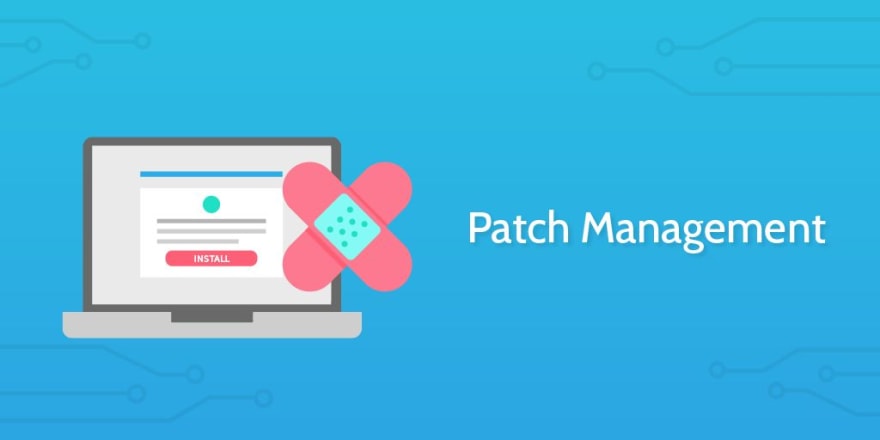Importance and Benefits of Patch Management
Cyber threats are more real than ever before. Hackers are finding new ways each day to access your systems and steal your data, and they aren't going away any time soon. To keep your data safe, your network security must be up to par and known vulnerabilities need to be remedied immediately.
This is where patch management comes into play. It's arguably one of the most important aspects of software security today and can help lower the risk of breaches to your system.
Patch Management Definition
Think of a patch as similar to a small update. It's a piece of code that fixes a functionality bug or a possible security vulnerability. A patch allows developers to fix something smaller without having to rework the entire code bases of a software program.
Patches can be applied to your infrastructure, routers, or servers. Depending on how many different software programs you're using, there could be patches coming in daily that affect your infrastructure and your staff. Managing these effectively is a must.
Patch management allows your company to manage all the patches that come out from various software vendors. You, or your patch management team, can determine which patches you need to keep your systems secure or up-to-date and be sure those patches are installed quickly and correctly.
Why Patch Management is Important In 2020, there were over 18,000 software vulnerabilities that were disclosed publicly, and half of the internal-facing web application vulnerabilities were high or critical risk. It was also found that 60% of data breaches came from known vulnerabilities that were not patched.
When these bugs get patched quickly and responsibly, it keeps hackers from breaching the security and pulling out your data. Patch management is important to get these patches out to fix security flaws before they are exploited.
In some industries, patches also help maintain regulatory compliance and keep your company on track with the regular updating of your software systems. Staying in compliance helps prevent fines for failure to comply in your industry.
Benefits of Patch Management
Patch management system can benefit your company in a variety of ways. A correctly applied patch can save your company hours and dollars, as well as keeping your network safe from hackers. Here are some of the benefits patch management can bring.
Network Security. This is the most critical reason for patch management. By securing your network before something happens, your company avoids dealing with data theft that can lead to legal issues and a damaged reputation.
Productivity. Up-to-date systems reduce the amount of employee downtime due to bugs. Your programs will run more smoothly with the latest code and your employees will be more efficient.
Remote Worker Protection. With so many people working from home and other remote locations, networks have a greater potential to be compromised. Remote monitoring and management are key to keeping your systems safe. Implementing a patch management plan can protect your company devices and ensure the safety of your information, no matter where your employees log in from.
Compliance. Industry regulations are increasing and companies are required to step up and follow new regulations imposed on them. Failure to do so can lead to fines and other legal penalties. Patch management can keep you compliant in your industry and help you follow best practices on cyber security.
Customer Service. When working with your customers, it's important that your technology works, and works well. If you are on the phone with them, or if they are using your technology themselves and it's filled with bugs, your company could lose business. Patch management helps fix any bugs and keeps your software working smoothly.
Product Innovation. With technology evolving every single day, it's crucial to stay up to date on the latest software and features that benefit your company. Patch management systems give you a way to deploy the latest innovations quickly, keeping you ahead of your competitors.
Best Practices for Patch Management
As with any system update, a strategic plan needs to be put into place to install new patches to your software. You need to take a look at the impact the patch will have on your systems and teams. Having a strategic patch management system can keep your systems safe while reducing costs. Here are a few best practices to consider before implementing your plan:
Prioritize. Base the order of deployment on how critical the patch is to your security or functionality.
Standardize. Establish policies that create a consistent patch process across your systems. Create expectations of each team member and hold them accountable for their roles in the process.
Automate. Automating as much of the process as possible decreases the time between the release of the patch and the application.
Test. Most likely, your systems have a test environment. Deploy the patch there first to look for any unintended mishaps. Once it has been deployed in your test environment, release it to the production environment.
Disaster Recovery. Have a backup plan, just in case your patch management process fails. Disaster recovery plans can get your systems back up and running quickly in the event of an emergency. Automated patch management systems can save a lot of time and money and keep your systems safe from hackers. They can also help prevent legal issues from a data breach. Patching is a definite Must-Do IT management practice for organizations of any size.




Top comments (0)